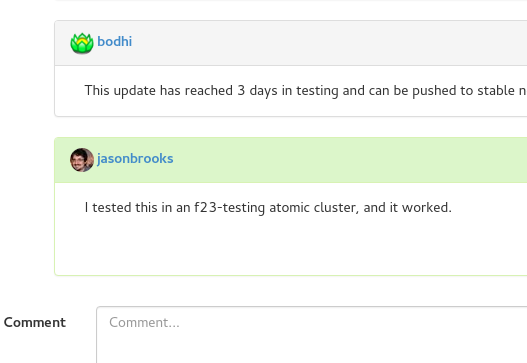I noticed today (maybe I’ve noticed before, but forgotten) that the version of flannel in Fedora 23 is older than what’s available in CentOS. It looks like this is because no one tested the more-recent version of flannel in Fedora’s Bodhi, a pretty awesome application for testing packages.
Why not? Maybe because it isn’t always obvious how to test a package like flannel, but I here’s how I tested it, and added karma to the package in Bodhi.
I use flannel when I cluster atomic hosts together with kubernetes. I typically use the release versions of centos or fedora atomic, but the fedora project also provides an ostree image built from fedora’s updates-testing repo, where packages await karma from testers. I prepare three atomic hosts with vagrant:
[my-laptop]$ git clone https://github.com/jasonbrooks/contrib.git [my-laptop]$ cd contrib/ansible/vagrant [my-laptop]$ export DISTRO_TYPE=fedora-atomic [my-laptop]$ vagrant up --no-provision --provider=libvirt
Next, I rebase the trio of hosts to the testing tree:
[my-laptop]$ for i in {kube-node-1,kube-master,kube-node-2}; do vagrant ssh $i -c "sudo rpm-ostree rebase fedora-atomic:fedora-atomic/f23/x86_64/testing/docker-host"; done
[my-laptop]$ vagrant reload --no-provision && vagrant provision kube-master
Reloading the hosts switches them to the testing image, and runs the ansible provisioning scripts that configure the kubernetes cluster. Now to ssh to one of the boxes, confirm that I’m running an image with the newer flannel, and then run a test app on the cluster to make sure that everything is in order:
[my-laptop]$ vagrant ssh kube-master [kube-master]$ rpm -q flannel flannel-0.5.4-1.fc23.x86_64 [kube-master]$ sudo atomic host status TIMESTAMP (UTC) VERSION ID OSNAME REFSPEC * 2016-02-03 22:47:33 23.63 65cc265ae1 fedora-atomic fedora-atomic:fedora-atomic/f23/x86_64/testing/docker-host 2016-01-26 18:16:33 23.53 22f0b303da fedora-atomic fedora-atomic:fedora-atomic/f23/x86_64/docker-host [kube-master]$ sudo atomic run projectatomic/guestbookgo-atomicapp
That last command pulls down an atomicapp container that deploys a guestbook example app from the kubernetes project. The app includes two redis slaves, a redis master, and a trio of frontend apps that talk to those backend pieces. The bits of the app are spread between my two kubelet nodes, with flannel handling the networking in-between. If this app is working, then I’m confident that
flannel is working.
[kube-master]$ kubectl get svc guestbook NAME CLUSTER_IP EXTERNAL_IP PORT(S) SELECTOR AGE guestbook 10.254.233.237 3000/TCP app=guestbook 55m [kube-master]$ exit [my-laptop]$ vagrant ssh kube-node-1 [kube-node-1]$ curl http://10.254.233.237:3000/info # Server redis_version:2.8.19 redis_git_sha1:00000000 redis_git_dirty:0 redis_build_id:c0359e7aa3798aa2 ....
The app is working, flannel appears to be doing its job, so I marched off to bodhi to offer up my karma:


Leave a comment